BF2_CapBud_Fall 2013.ppt
- Количество слайдов: 59
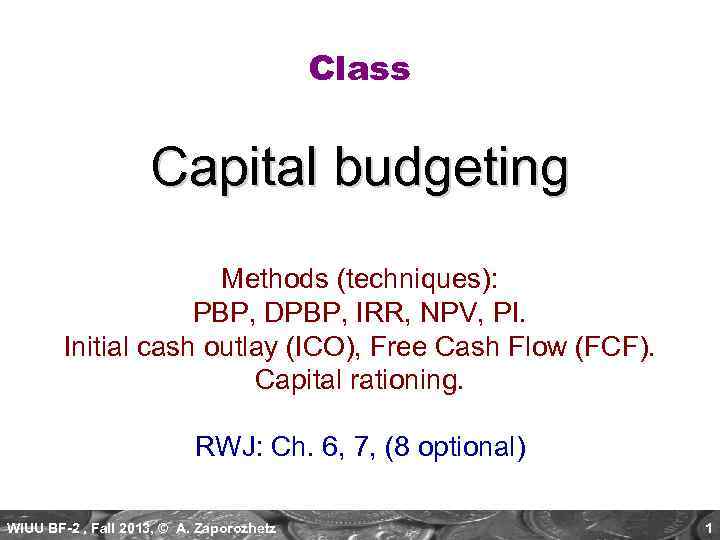
Class Capital budgeting Methods (techniques): PBP, DPBP, IRR, NPV, PI. Initial cash outlay (ICO), Free Cash Flow (FCF). Capital rationing. RWJ: Ch. 6, 7, (8 optional) WIUU BF-2 , Fall 2013, © A. Zaporozhetz 1
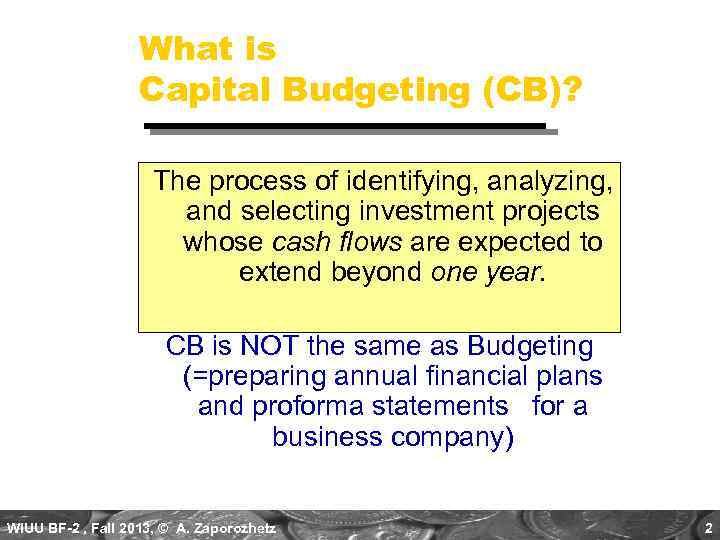
What is Capital Budgeting (CB)? The process of identifying, analyzing, and selecting investment projects whose cash flows are expected to extend beyond one year. CB is NOT the same as Budgeting (=preparing annual financial plans and proforma statements for a business company) WIUU BF-2 , Fall 2013, © A. Zaporozhetz 2
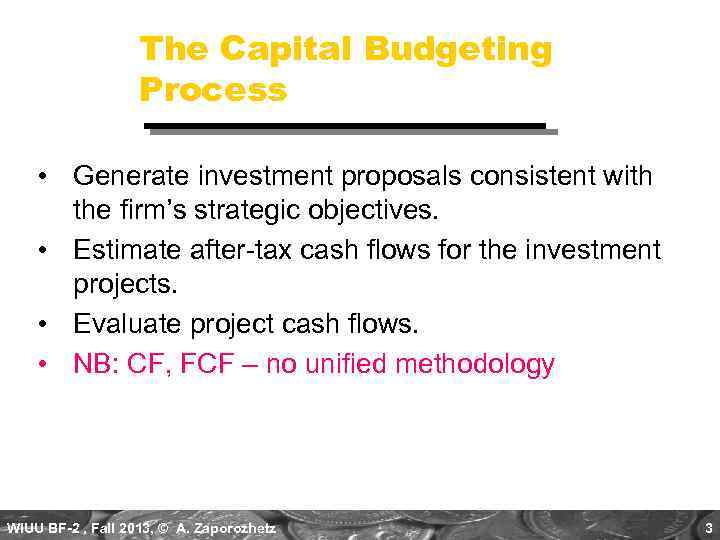
The Capital Budgeting Process • Generate investment proposals consistent with the firm’s strategic objectives. • Estimate after-tax cash flows for the investment projects. • Evaluate project cash flows. • NB: CF, FCF – no unified methodology WIUU BF-2 , Fall 2013, © A. Zaporozhetz 3
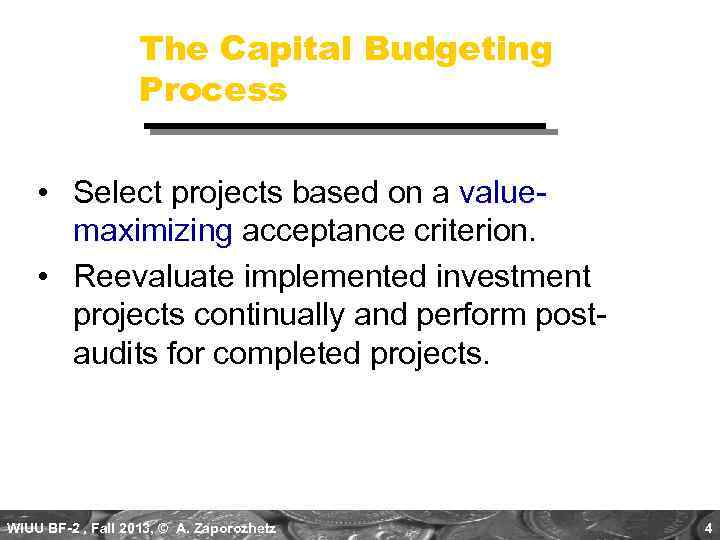
The Capital Budgeting Process • Select projects based on a valuemaximizing acceptance criterion. • Reevaluate implemented investment projects continually and perform postaudits for completed projects. WIUU BF-2 , Fall 2013, © A. Zaporozhetz 4
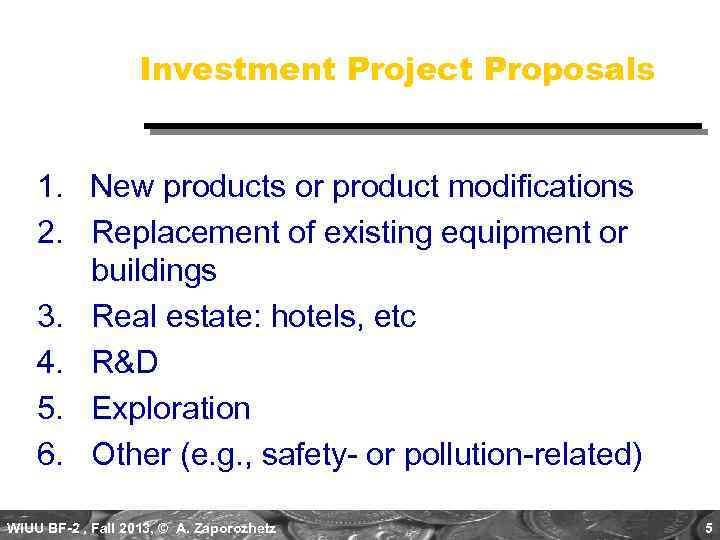
Investment Project Proposals 1. New products or product modifications 2. Replacement of existing equipment or buildings 3. Real estate: hotels, etc 4. R&D 5. Exploration 6. Other (e. g. , safety- or pollution-related) WIUU BF-2 , Fall 2013, © A. Zaporozhetz 5
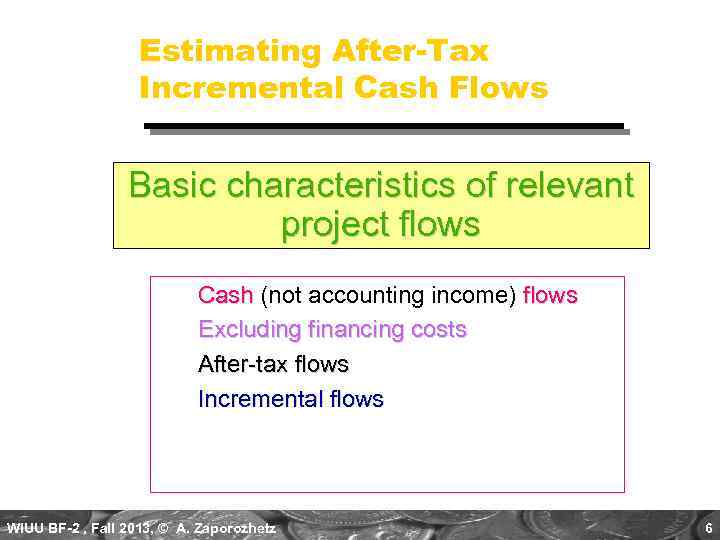
Estimating After-Tax Incremental Cash Flows Basic characteristics of relevant project flows Cash (not accounting income) flows Excluding financing costs After-tax flows Incremental flows WIUU BF-2 , Fall 2013, © A. Zaporozhetz 6
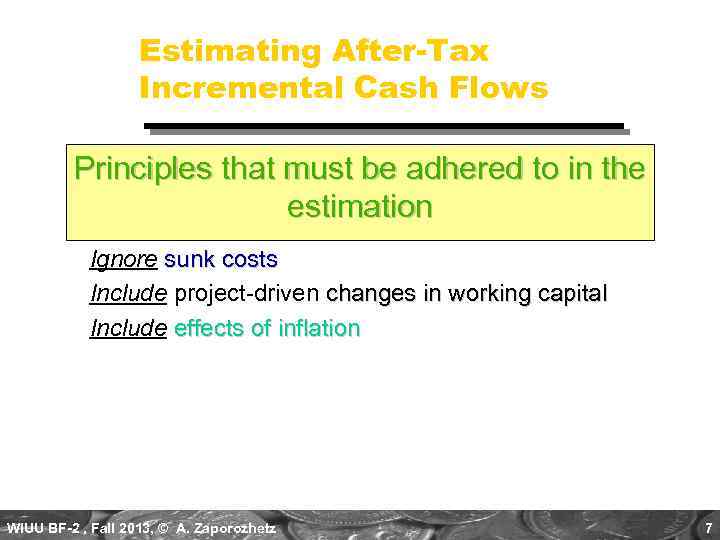
Estimating After-Tax Incremental Cash Flows Principles that must be adhered to in the estimation Ignore sunk costs Include project-driven changes in working capital Include effects of inflation WIUU BF-2 , Fall 2013, © A. Zaporozhetz 7
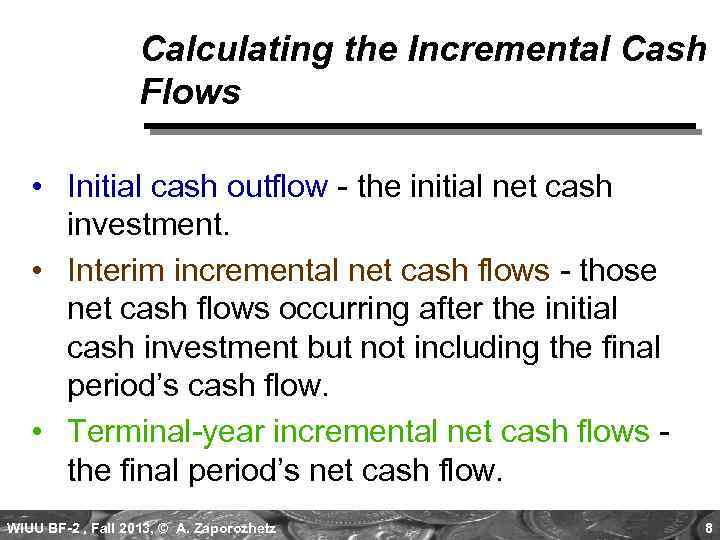
Calculating the Incremental Cash Flows • Initial cash outflow - the initial net cash investment. • Interim incremental net cash flows - those net cash flows occurring after the initial cash investment but not including the final period’s cash flow. • Terminal-year incremental net cash flows the final period’s net cash flow. WIUU BF-2 , Fall 2013, © A. Zaporozhetz 8
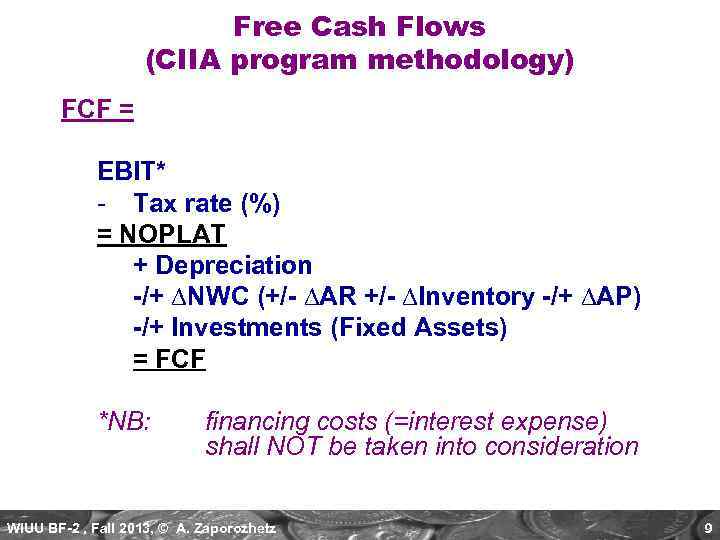
Free Cash Flows (CIIA program methodology) FCF = EBIT* - Tax rate (%) = NOPLAT + Depreciation -/+ ∆NWC (+/- ∆AR +/- ∆Inventory -/+ ∆AP) -/+ Investments (Fixed Assets) = FCF *NB: financing costs (=interest expense) shall NOT be taken into consideration WIUU BF-2 , Fall 2013, © A. Zaporozhetz 9
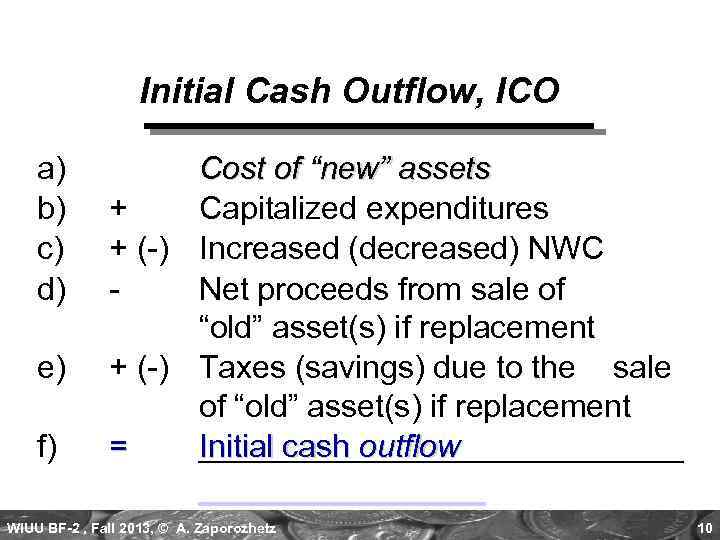
Initial Cash Outflow, ICO a) b) c) d) e) f) Cost of “new” assets + Capitalized expenditures + (-) Increased (decreased) NWC Net proceeds from sale of “old” asset(s) if replacement + (-) Taxes (savings) due to the sale of “old” asset(s) if replacement = Initial cash outflow WIUU BF-2 , Fall 2013, © A. Zaporozhetz 10
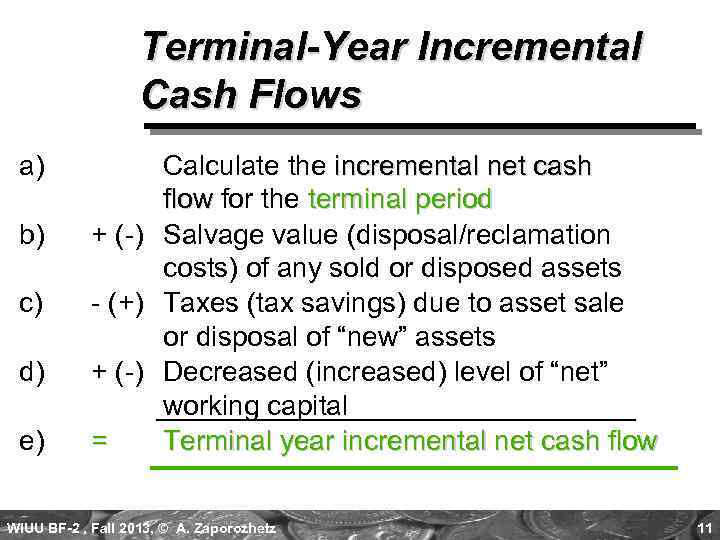
Terminal-Year Incremental Cash Flows a) b) c) d) e) Calculate the incremental net cash flow for the terminal period + (-) Salvage value (disposal/reclamation costs) of any sold or disposed assets - (+) Taxes (tax savings) due to asset sale or disposal of “new” assets + (-) Decreased (increased) level of “net” working capital = Terminal year incremental net cash flow WIUU BF-2 , Fall 2013, © A. Zaporozhetz 11
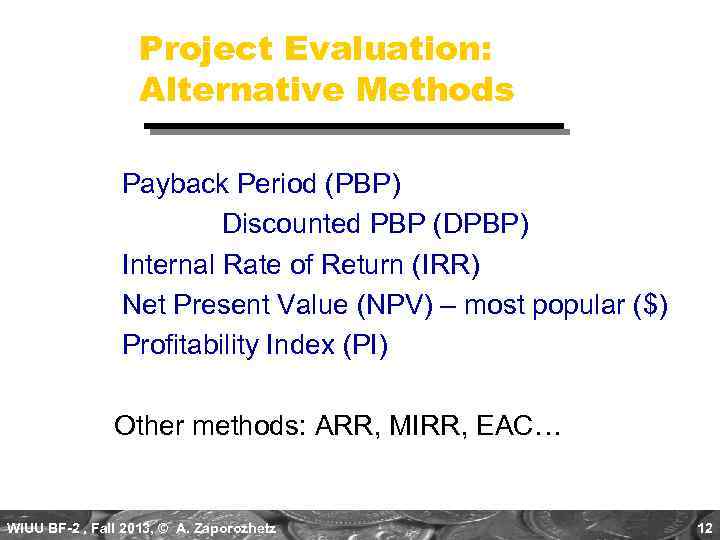
Project Evaluation: Alternative Methods Payback Period (PBP) Discounted PBP (DPBP) Internal Rate of Return (IRR) Net Present Value (NPV) – most popular ($) Profitability Index (PI) Other methods: ARR, MIRR, EAC… WIUU BF-2 , Fall 2013, © A. Zaporozhetz 12
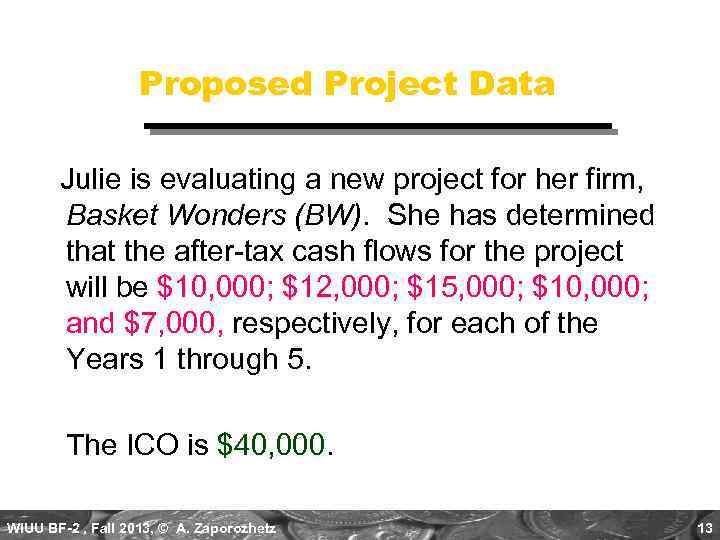
Proposed Project Data Julie is evaluating a new project for her firm, Basket Wonders (BW). She has determined that the after-tax cash flows for the project will be $10, 000; $12, 000; $15, 000; $10, 000; and $7, 000, respectively, for each of the Years 1 through 5. The ICO is $40, 000. WIUU BF-2 , Fall 2013, © A. Zaporozhetz 13
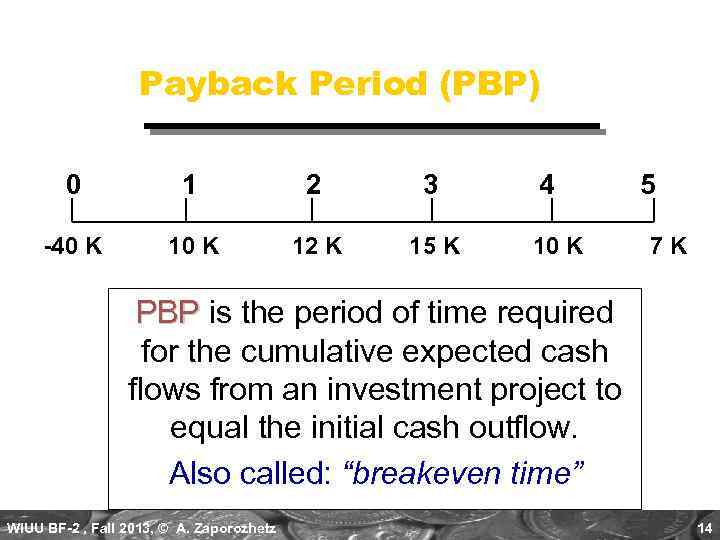
Payback Period (PBP) 0 1 2 3 -40 K 12 K 15 K 4 10 K 5 7 K PBP is the period of time required for the cumulative expected cash flows from an investment project to equal the initial cash outflow. Also called: “breakeven time” WIUU BF-2 , Fall 2013, © A. Zaporozhetz 14

Payback Solution (#1) 0 -40 K (-b) Cumulative Inflows 1 2 10 K 12 K 22 K 3 (a) 15 K 37 K(c) 4 10 K(d) 47 K 5 7 K 54 K PBP =a+(b-c)/d = 3 + (40 - 37) / 10 = 3 + (3 / 10) = 3. 30 Years WIUU BF-2 , Fall 2013, © A. Zaporozhetz 15
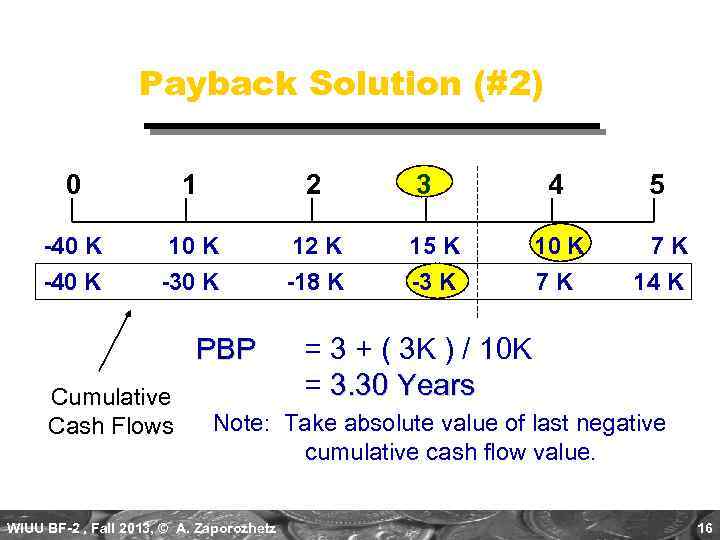
Payback Solution (#2) 0 1 2 -40 K 12 K 15 K 10 K -40 K -30 K -18 K -3 K 7 K PBP Cumulative Cash Flows 3 4 5 7 K 14 K = 3 + ( 3 K ) / 10 K = 3. 30 Years Note: Take absolute value of last negative cumulative cash flow value. WIUU BF-2 , Fall 2013, © A. Zaporozhetz 16
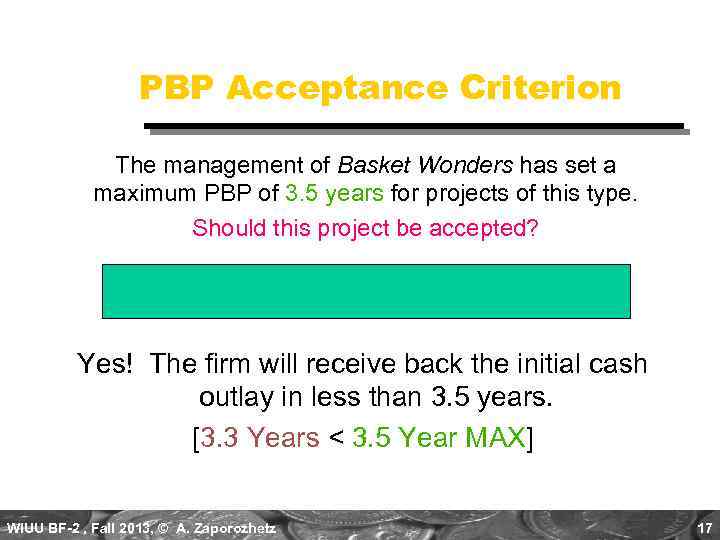
PBP Acceptance Criterion The management of Basket Wonders has set a maximum PBP of 3. 5 years for projects of this type. Should this project be accepted? Yes! The firm will receive back the initial cash outlay in less than 3. 5 years. [3. 3 Years < 3. 5 Year MAX] WIUU BF-2 , Fall 2013, © A. Zaporozhetz 17
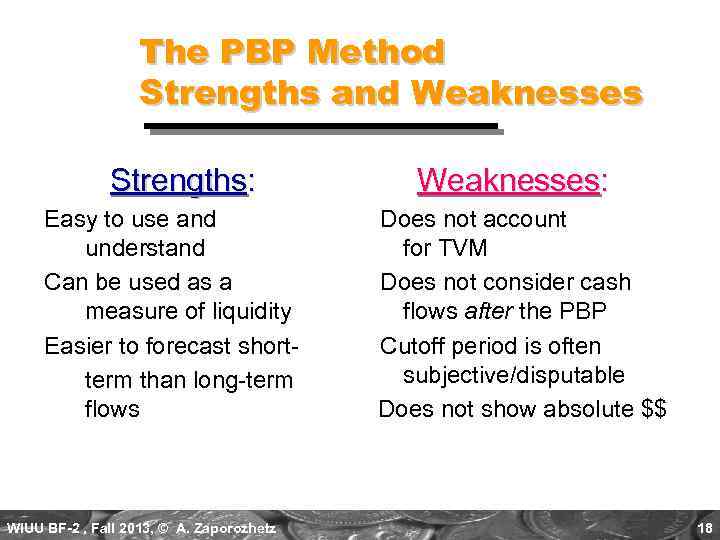
The PBP Method Strengths and Weaknesses Strengths: Easy to use and understand Can be used as a measure of liquidity Easier to forecast shortterm than long-term flows WIUU BF-2 , Fall 2013, © A. Zaporozhetz Weaknesses: Does not account for TVM Does not consider cash flows after the PBP Cutoff period is often subjective/disputable Does not show absolute $$ 18
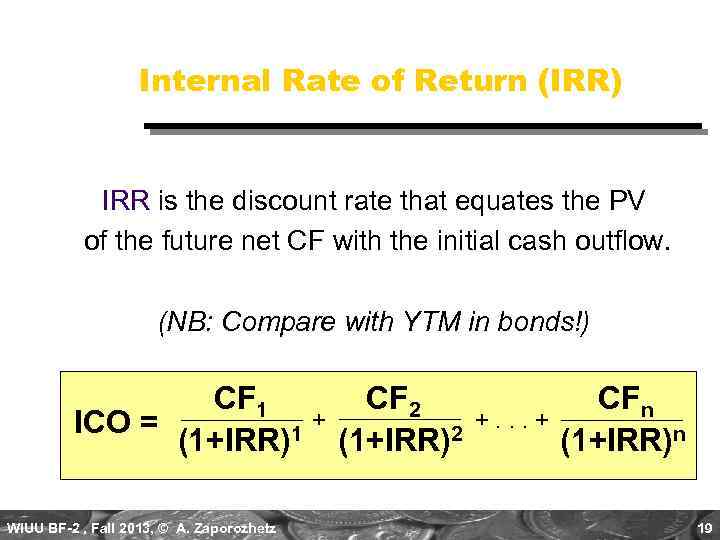
Internal Rate of Return (IRR) IRR is the discount rate that equates the PV of the future net CF with the initial cash outflow. (NB: Compare with YTM in bonds!) CF 1 ICO = (1+IRR)1 WIUU BF-2 , Fall 2013, © A. Zaporozhetz + CF 2 (1+IRR)2 +. . . + CFn (1+IRR)n 19
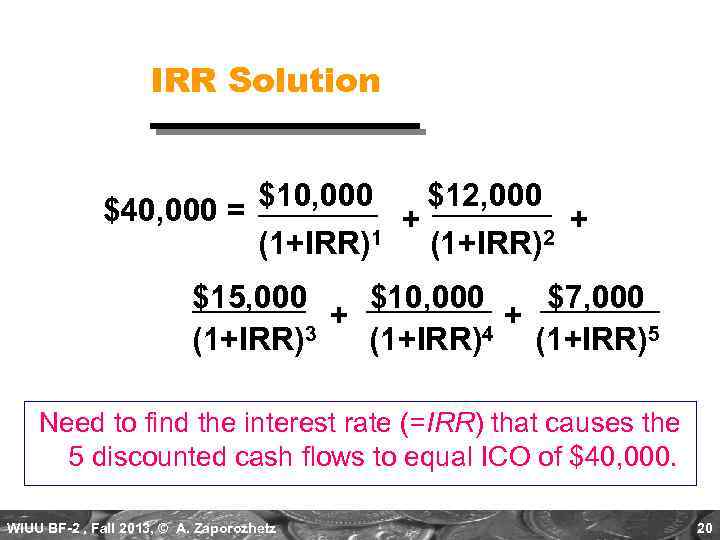
IRR Solution $10, 000 $12, 000 $40, 000 = + + (1+IRR)1 (1+IRR)2 $15, 000 $10, 000 $7, 000 + + (1+IRR)3 (1+IRR)4 (1+IRR)5 Need to find the interest rate (=IRR) that causes the 5 discounted cash flows to equal ICO of $40, 000. WIUU BF-2 , Fall 2013, © A. Zaporozhetz 20
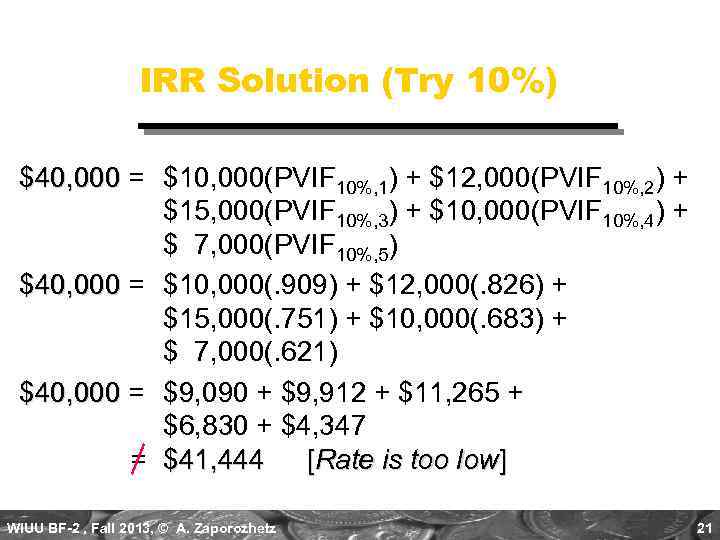
IRR Solution (Try 10%) $40, 000 = $10, 000(PVIF 10%, 1) + $12, 000(PVIF 10%, 2) + $15, 000(PVIF 10%, 3) + $10, 000(PVIF 10%, 4) + $ 7, 000(PVIF 10%, 5) $40, 000 = $10, 000(. 909) + $12, 000(. 826) + $15, 000(. 751) + $10, 000(. 683) + $ 7, 000(. 621) $40, 000 = $9, 090 + $9, 912 + $11, 265 + $6, 830 + $4, 347 = $41, 444 [Rate is too low] WIUU BF-2 , Fall 2013, © A. Zaporozhetz 21
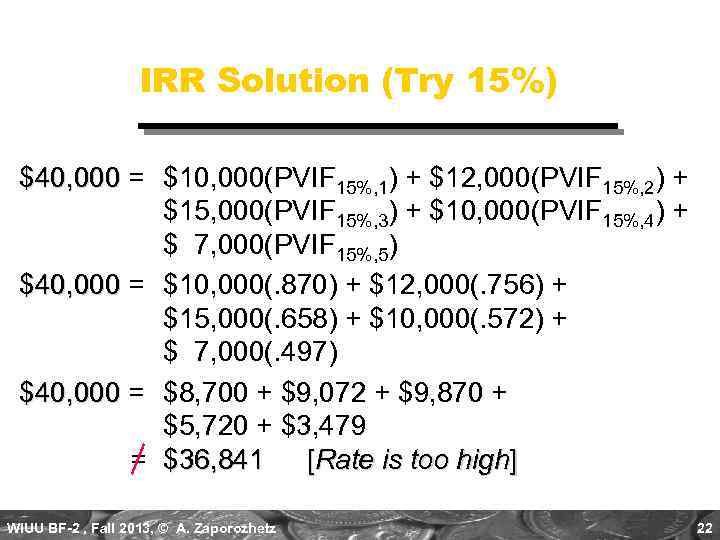
IRR Solution (Try 15%) $40, 000 = $10, 000(PVIF 15%, 1) + $12, 000(PVIF 15%, 2) + $15, 000(PVIF 15%, 3) + $10, 000(PVIF 15%, 4) + $ 7, 000(PVIF 15%, 5) $40, 000 = $10, 000(. 870) + $12, 000(. 756) + $15, 000(. 658) + $10, 000(. 572) + $ 7, 000(. 497) $40, 000 = $8, 700 + $9, 072 + $9, 870 + $5, 720 + $3, 479 = $36, 841 [Rate is too high] WIUU BF-2 , Fall 2013, © A. Zaporozhetz 22
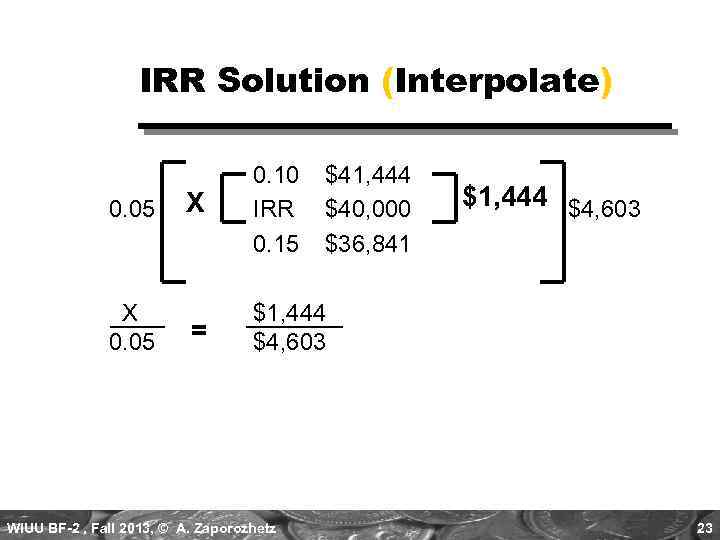
IRR Solution (Interpolate) 0. 05 X 0. 10 IRR 0. 15 = $1, 444 $4, 603 WIUU BF-2 , Fall 2013, © A. Zaporozhetz $41, 444 $40, 000 $36, 841 $1, 444 $4, 603 23
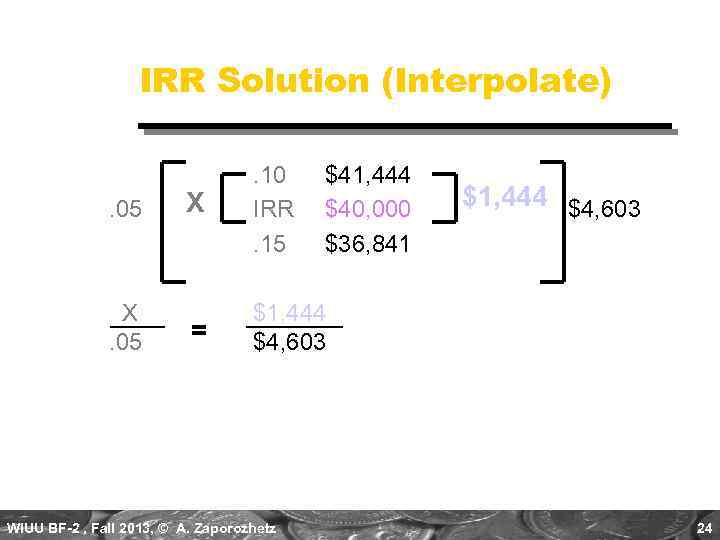
IRR Solution (Interpolate) . 05 X . 10 IRR. 15 = $1, 444 $4, 603 WIUU BF-2 , Fall 2013, © A. Zaporozhetz $41, 444 $40, 000 $36, 841 $1, 444 $4, 603 24
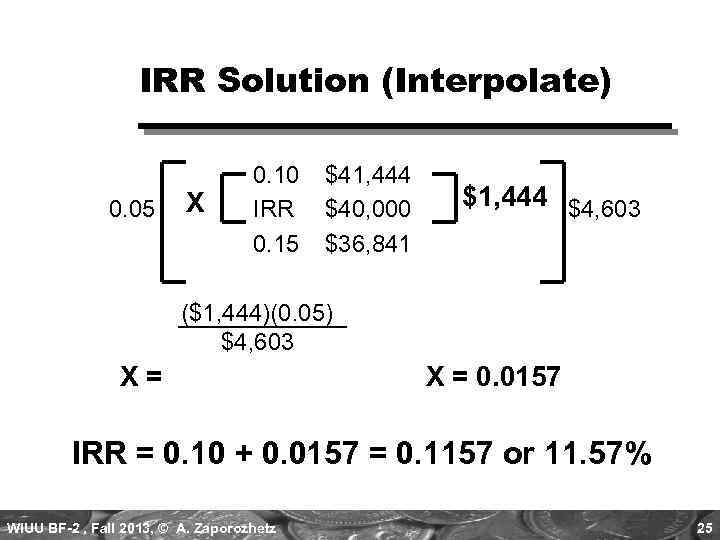
IRR Solution (Interpolate) 0. 05 X 0. 10 IRR 0. 15 $41, 444 $40, 000 $36, 841 $1, 444 $4, 603 ($1, 444)(0. 05) $4, 603 X= X = 0. 0157 IRR = 0. 10 + 0. 0157 = 0. 1157 or 11. 57% WIUU BF-2 , Fall 2013, © A. Zaporozhetz 25
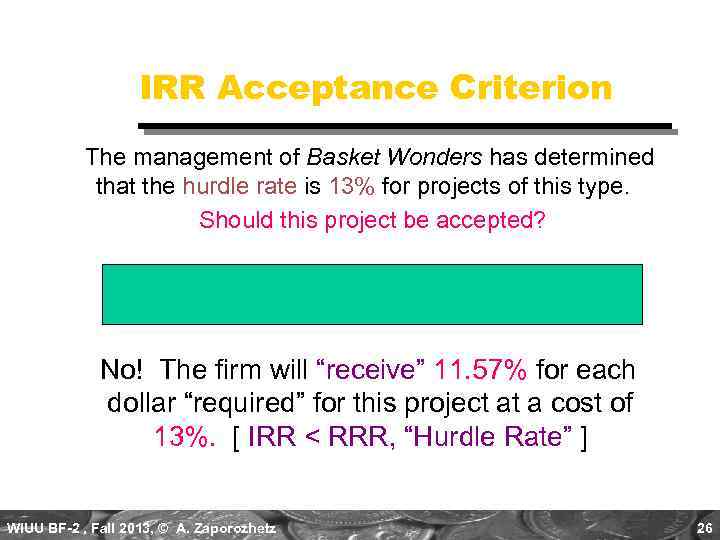
IRR Acceptance Criterion The management of Basket Wonders has determined that the hurdle rate is 13% for projects of this type. Should this project be accepted? No! The firm will “receive” 11. 57% for each dollar “required” for this project at a cost of 13%. [ IRR < RRR, “Hurdle Rate” ] WIUU BF-2 , Fall 2013, © A. Zaporozhetz 26
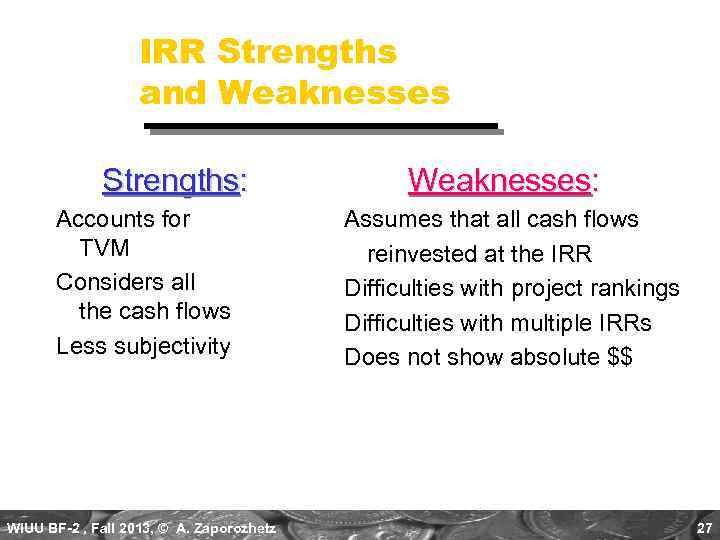
IRR Strengths and Weaknesses Strengths: Accounts for TVM Considers all the cash flows Less subjectivity WIUU BF-2 , Fall 2013, © A. Zaporozhetz Weaknesses: Assumes that all cash flows reinvested at the IRR Difficulties with project rankings Difficulties with multiple IRRs Does not show absolute $$ 27
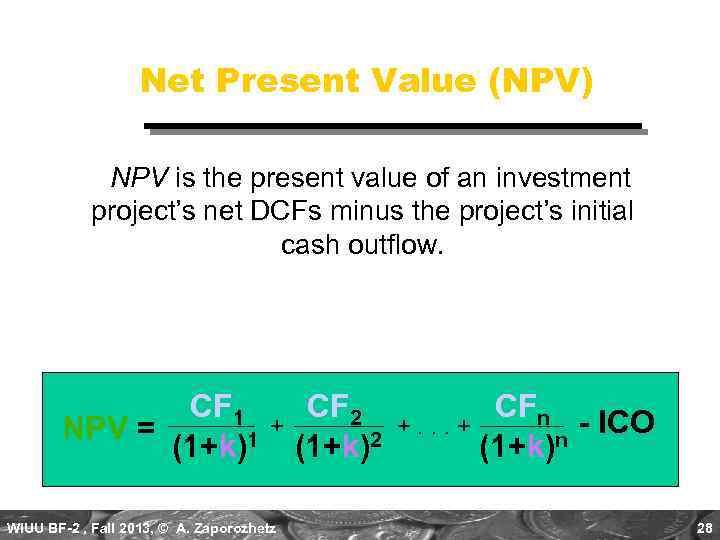
Net Present Value (NPV) NPV is the present value of an investment project’s net DCFs minus the project’s initial cash outflow. CF 1 NPV = (1+k)1 + WIUU BF-2 , Fall 2013, © A. Zaporozhetz CF 2 (1+k)2 CFn - ICO +. . . + n (1+k) 28
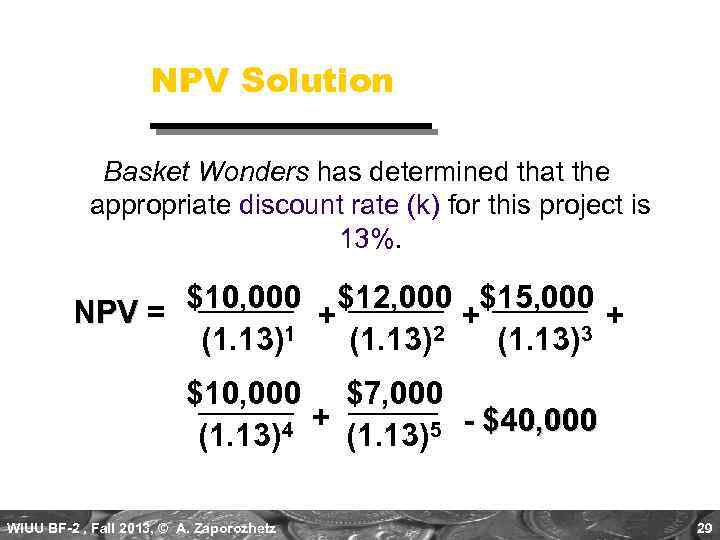
NPV Solution Basket Wonders has determined that the appropriate discount rate (k) for this project is 13%. NPV = $10, 000 +$12, 000 +$15, 000 + (1. 13)1 (1. 13)2 (1. 13)3 $10, 000 $7, 000 4 + (1. 13)5 - $40, 000 (1. 13) WIUU BF-2 , Fall 2013, © A. Zaporozhetz 29
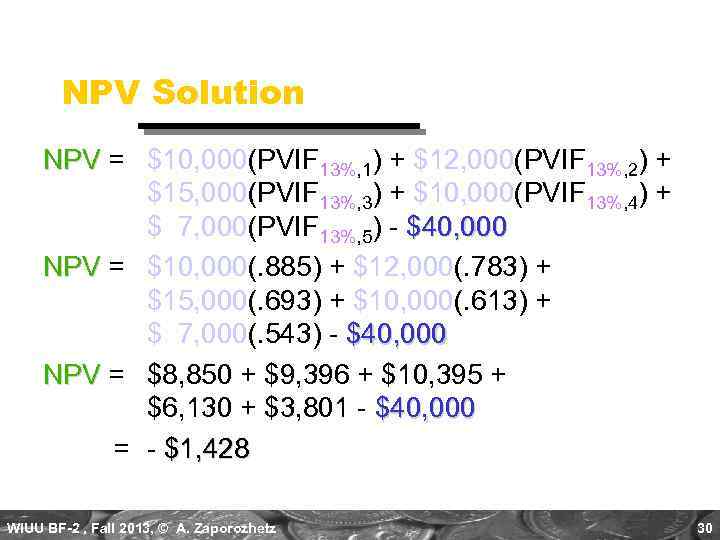
NPV Solution NPV = $10, 000(PVIF 13%, 1) + $12, 000(PVIF 13%, 2) + $15, 000(PVIF 13%, 3) + $10, 000(PVIF 13%, 4) + $ 7, 000(PVIF 13%, 5) - $40, 000 NPV = $10, 000(. 885) + $12, 000(. 783) + $15, 000(. 693) + $10, 000(. 613) + $ 7, 000(. 543) - $40, 000 NPV = $8, 850 + $9, 396 + $10, 395 + $6, 130 + $3, 801 - $40, 000 = - $1, 428 WIUU BF-2 , Fall 2013, © A. Zaporozhetz 30
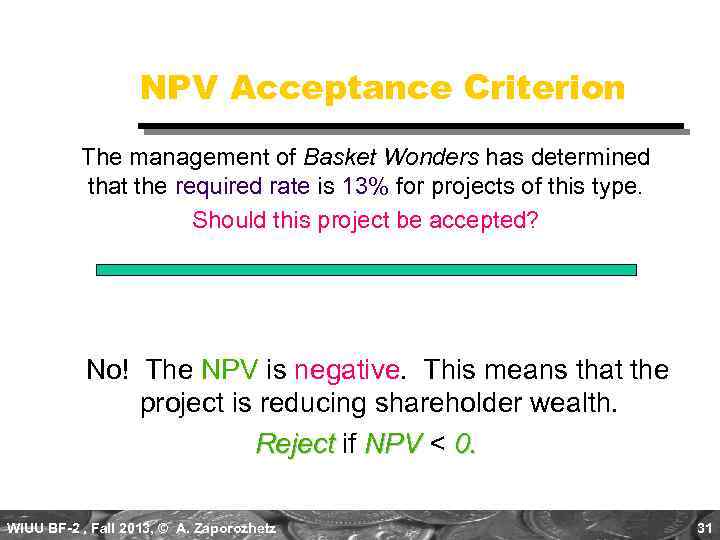
NPV Acceptance Criterion The management of Basket Wonders has determined that the required rate is 13% for projects of this type. Should this project be accepted? No! The NPV is negative. This means that the project is reducing shareholder wealth. Reject if NPV < 0. WIUU BF-2 , Fall 2013, © A. Zaporozhetz 31
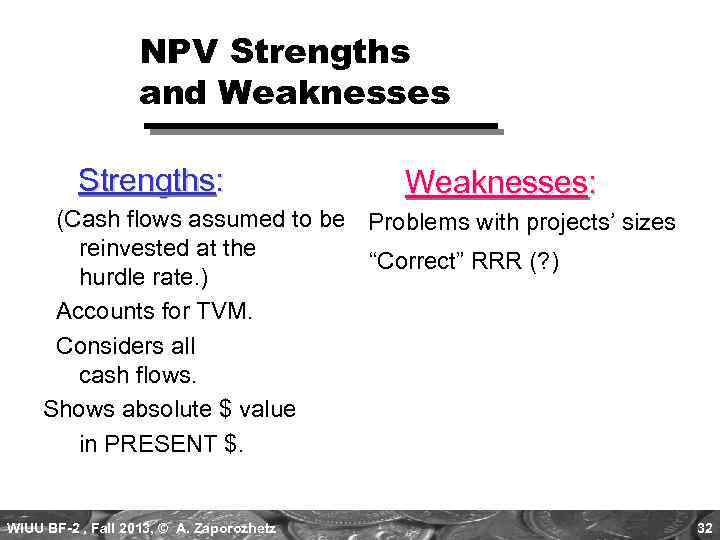
NPV Strengths and Weaknesses Strengths: Weaknesses: (Cash flows assumed to be Problems with projects’ sizes reinvested at the “Correct” RRR (? ) hurdle rate. ) Accounts for TVM. Considers all cash flows. Shows absolute $ value in PRESENT $. WIUU BF-2 , Fall 2013, © A. Zaporozhetz 32
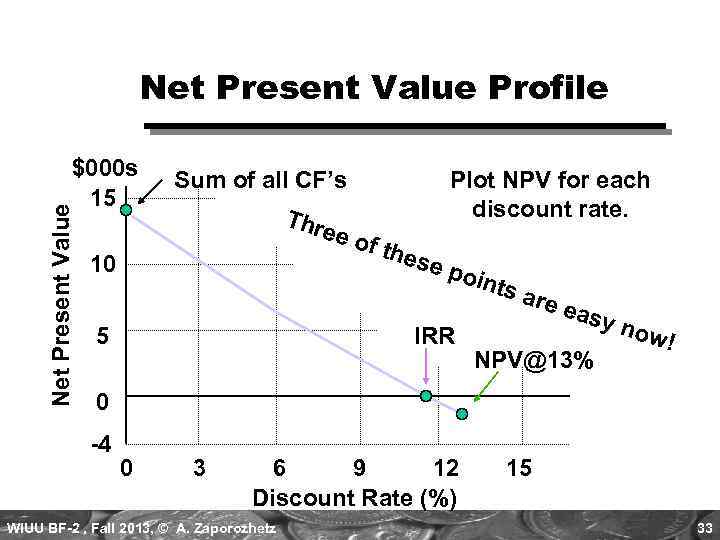
Net Present Value Profile Net Present Value $000 s 15 Sum of all CF’s Thre e 10 5 Plot NPV for each discount rate. of th e se p oint s IRR are eas NPV@13% y no w! 0 -4 0 3 6 9 12 Discount Rate (%) WIUU BF-2 , Fall 2013, © A. Zaporozhetz 15 33
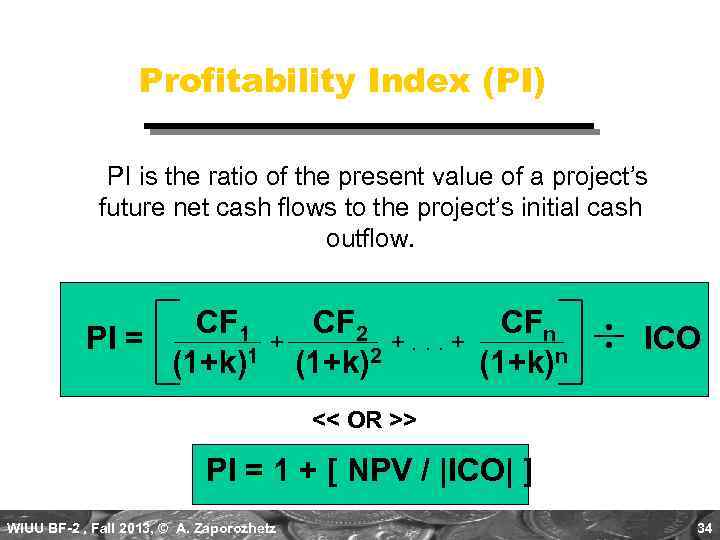
Profitability Index (PI) PI is the ratio of the present value of a project’s future net cash flows to the project’s initial cash outflow. CF 1 PI = (1+k)1 + CF 2 CFn +. . . + 2 (1+k)n ICO << OR >> PI = 1 + [ NPV / |ICO| ] WIUU BF-2 , Fall 2013, © A. Zaporozhetz 34
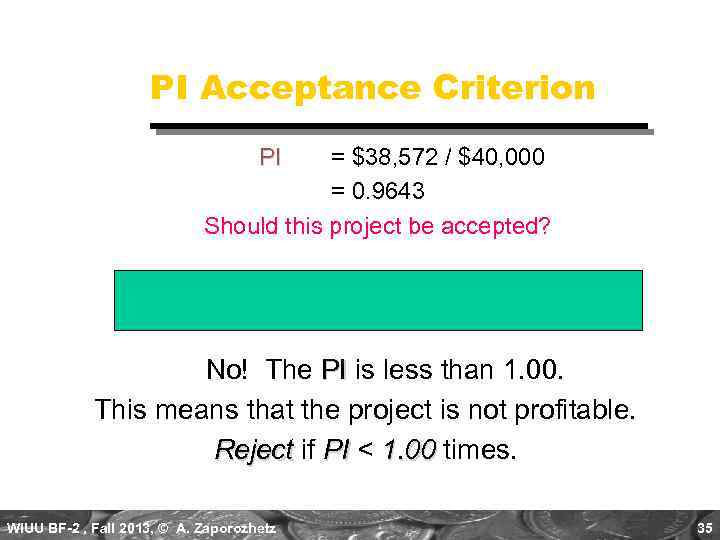
PI Acceptance Criterion PI = $38, 572 / $40, 000 = 0. 9643 Should this project be accepted? No! The PI is less than 1. 00. This means that the project is not profitable. Reject if PI < 1. 00 times. WIUU BF-2 , Fall 2013, © A. Zaporozhetz 35
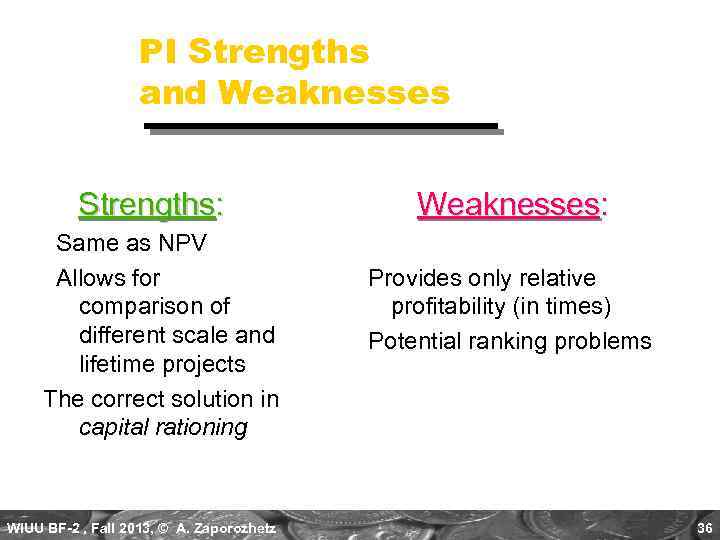
PI Strengths and Weaknesses Strengths: Same as NPV Allows for comparison of different scale and lifetime projects The correct solution in capital rationing WIUU BF-2 , Fall 2013, © A. Zaporozhetz Weaknesses: Provides only relative profitability (in times) Potential ranking problems 36
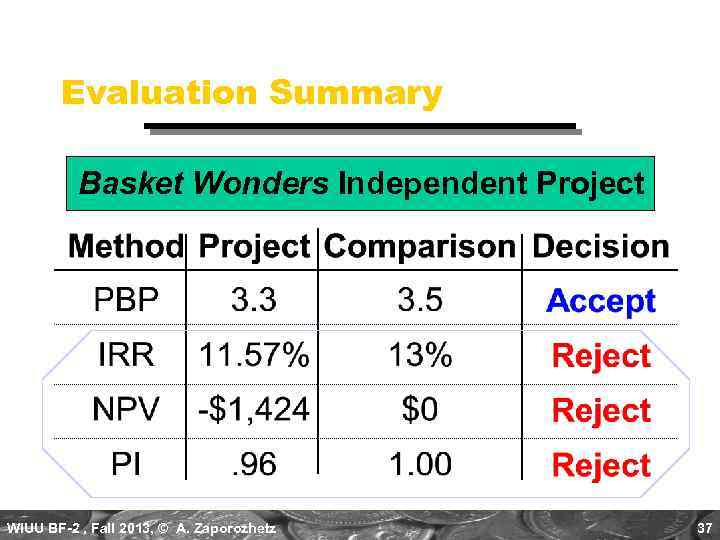
Evaluation Summary Basket Wonders Independent Project WIUU BF-2 , Fall 2013, © A. Zaporozhetz 37
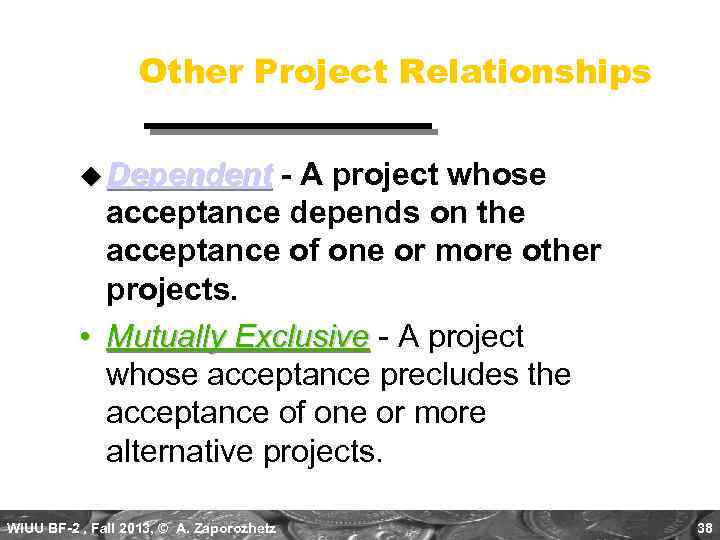
Other Project Relationships u Dependent - A project whose acceptance depends on the acceptance of one or more other projects. • Mutually Exclusive - A project whose acceptance precludes the acceptance of one or more alternative projects. WIUU BF-2 , Fall 2013, © A. Zaporozhetz 38
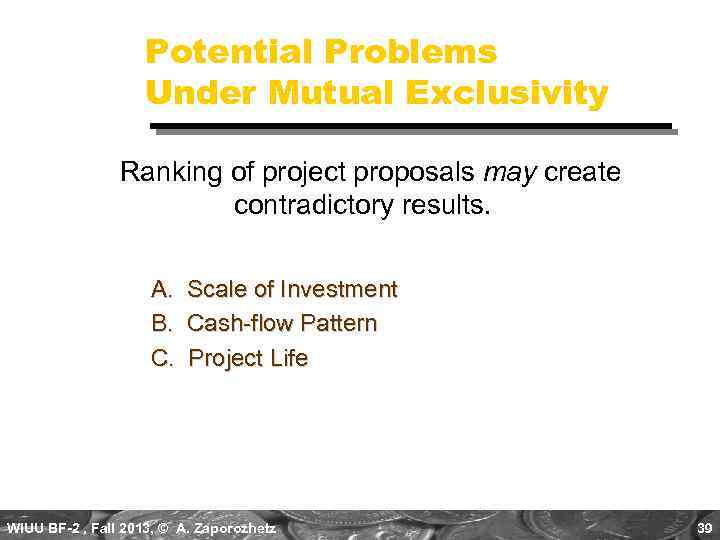
Potential Problems Under Mutual Exclusivity Ranking of project proposals may create contradictory results. A. B. C. Scale of Investment Cash-flow Pattern Project Life WIUU BF-2 , Fall 2013, © A. Zaporozhetz 39
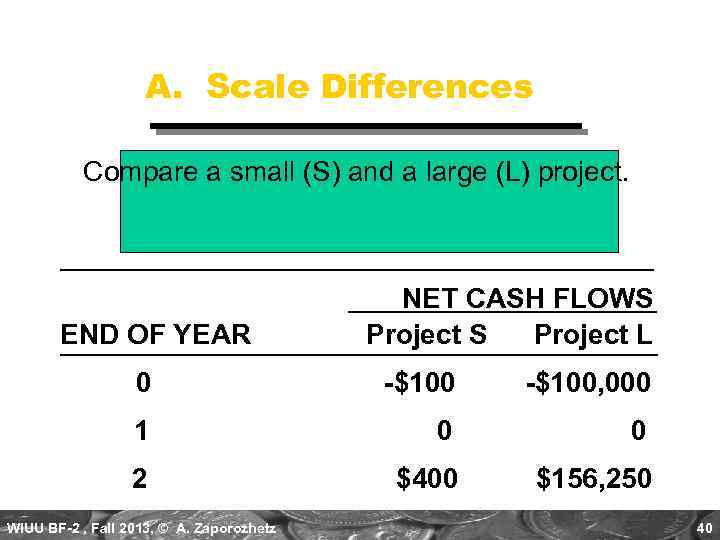
A. Scale Differences Compare a small (S) and a large (L) project. END OF YEAR NET CASH FLOWS Project L 0 -$100, 000 1 0 0 2 $400 $156, 250 WIUU BF-2 , Fall 2013, © A. Zaporozhetz 40
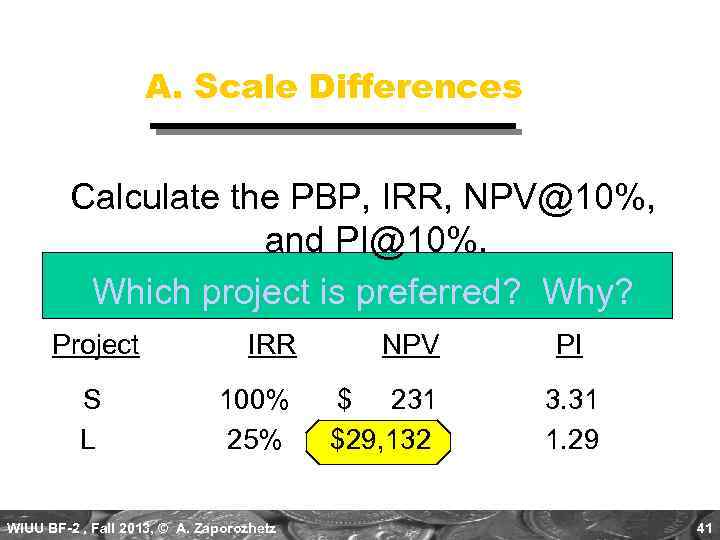
A. Scale Differences Calculate the PBP, IRR, NPV@10%, and PI@10%. Which project is preferred? Why? Project S L IRR NPV 100% 25% $ 231 $29, 132 WIUU BF-2 , Fall 2013, © A. Zaporozhetz PI 3. 31 1. 29 41
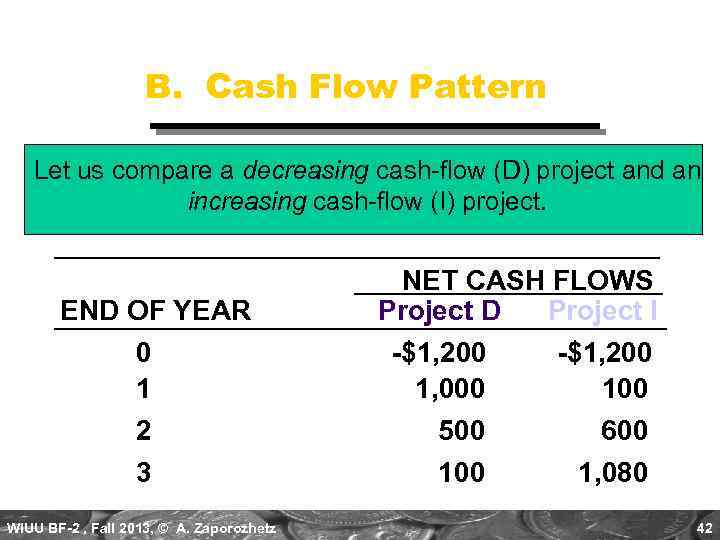
B. Cash Flow Pattern Let us compare a decreasing cash-flow (D) project and an increasing cash-flow (I) project. END OF YEAR 0 1 2 3 WIUU BF-2 , Fall 2013, © A. Zaporozhetz NET CASH FLOWS Project D Project I -$1, 200 1, 000 100 500 600 1, 080 42
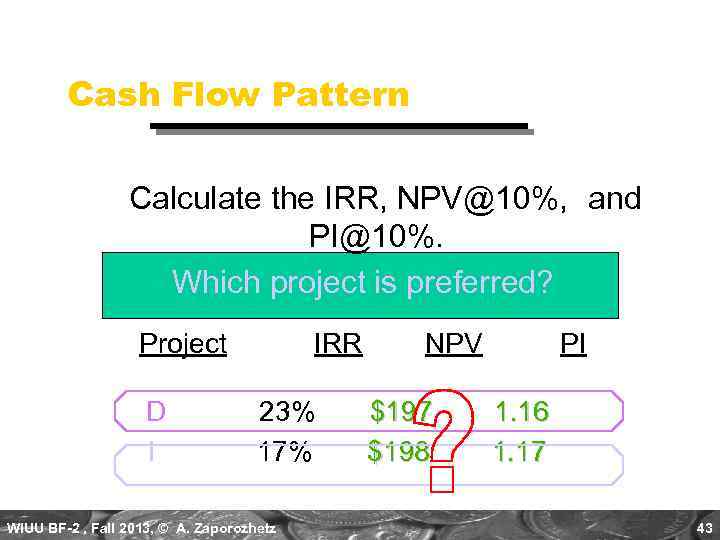
Cash Flow Pattern Calculate the IRR, NPV@10%, and PI@10%. Which project is preferred? Project D I IRR 23% 17% WIUU BF-2 , Fall 2013, © A. Zaporozhetz NPV $197 $198 PI 1. 16 1. 17 43
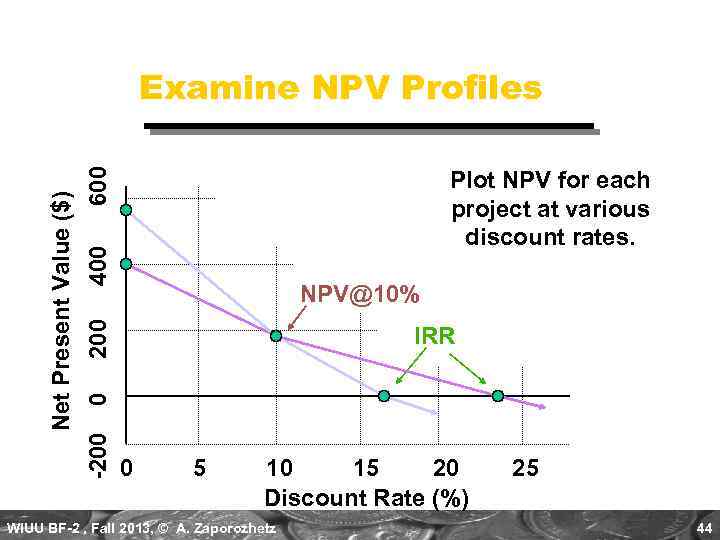
600 400 Plot NPV for each project at various discount rates. 200 NPV@10% IRR 0 -200 Net Present Value ($) Examine NPV Profiles 0 5 10 15 20 Discount Rate (%) WIUU BF-2 , Fall 2013, © A. Zaporozhetz 25 44
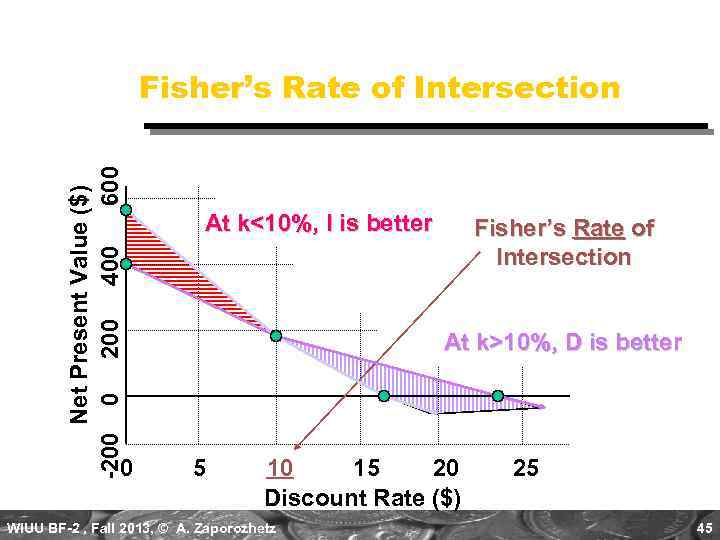
Net Present Value ($) -200 0 200 400 600 Fisher’s Rate of Intersection 0 At k<10%, I is better Fisher’s Rate of Intersection At k>10%, D is better 5 10 15 20 Discount Rate ($) WIUU BF-2 , Fall 2013, © A. Zaporozhetz 25 45
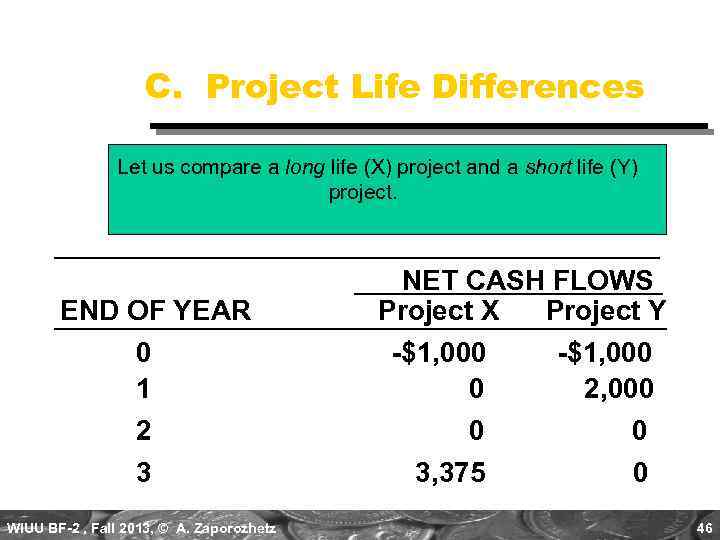
C. Project Life Differences Let us compare a long life (X) project and a short life (Y) project. END OF YEAR 0 1 2 3 WIUU BF-2 , Fall 2013, © A. Zaporozhetz NET CASH FLOWS Project X Project Y -$1, 000 0 2, 000 0 0 3, 375 0 46
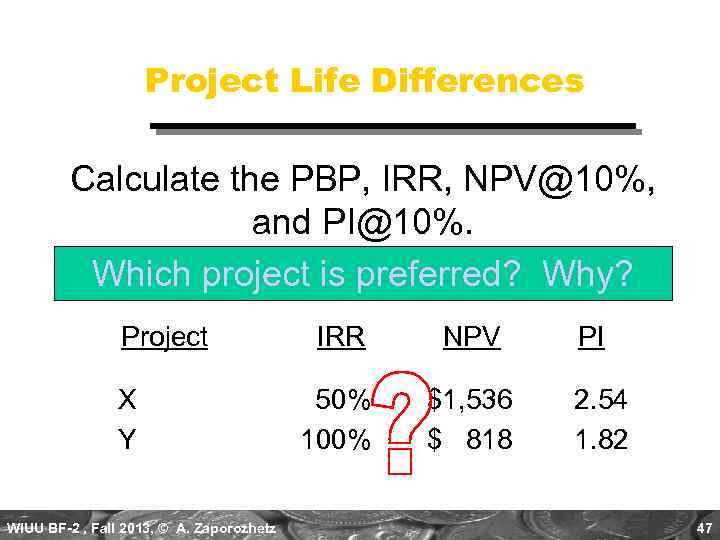
Project Life Differences Calculate the PBP, IRR, NPV@10%, and PI@10%. Which project is preferred? Why? Project X Y WIUU BF-2 , Fall 2013, © A. Zaporozhetz IRR NPV 50% 100% $1, 536 $ 818 PI 2. 54 1. 82 47
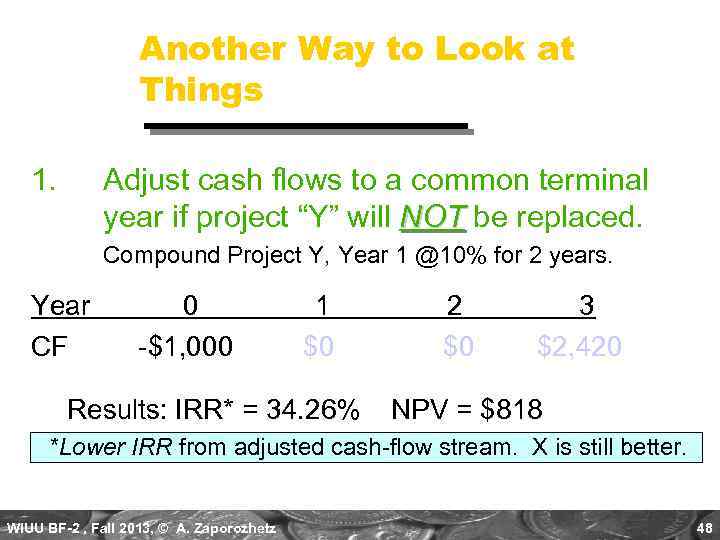
Another Way to Look at Things 1. Adjust cash flows to a common terminal year if project “Y” will NOT be replaced. Compound Project Y, Year 1 @10% for 2 years. Year CF 0 -$1, 000 1 $0 Results: IRR* = 34. 26% 2 $0 3 $2, 420 NPV = $818 *Lower IRR from adjusted cash-flow stream. X is still better. WIUU BF-2 , Fall 2013, © A. Zaporozhetz 48
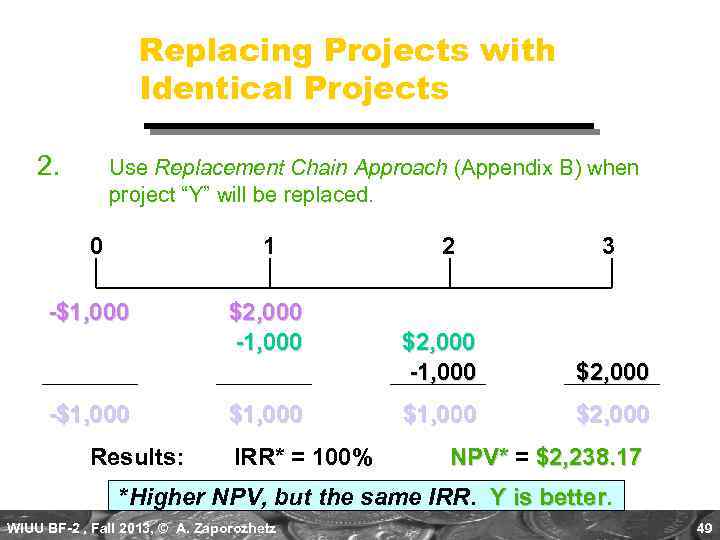
Replacing Projects with Identical Projects 2. Use Replacement Chain Approach (Appendix B) when project “Y” will be replaced. 0 1 -$1, 000 Results: $2, 000 -1, 000 $1, 000 IRR* = 100% 2 3 $2, 000 -1, 000 $2, 000 $1, 000 $2, 000 NPV* = $2, 238. 17 *Higher NPV, but the same IRR. Y is better WIUU BF-2 , Fall 2013, © A. Zaporozhetz 49
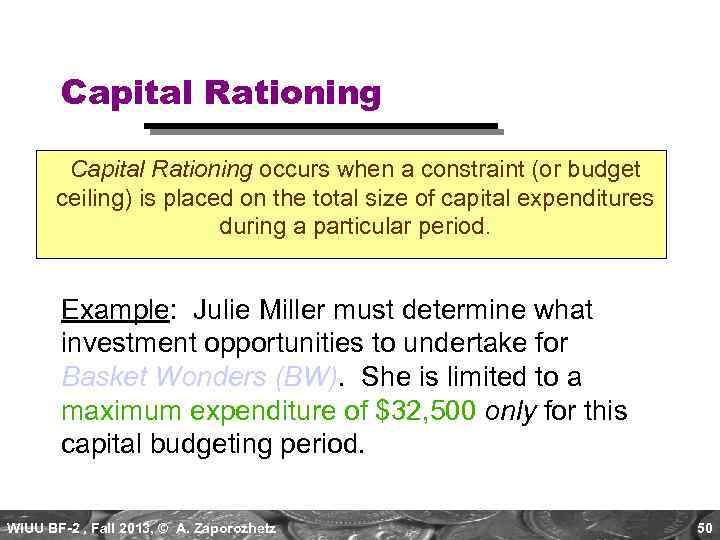
Capital Rationing occurs when a constraint (or budget ceiling) is placed on the total size of capital expenditures during a particular period. Example: Julie Miller must determine what investment opportunities to undertake for Basket Wonders (BW). She is limited to a maximum expenditure of $32, 500 only for this capital budgeting period. WIUU BF-2 , Fall 2013, © A. Zaporozhetz 50
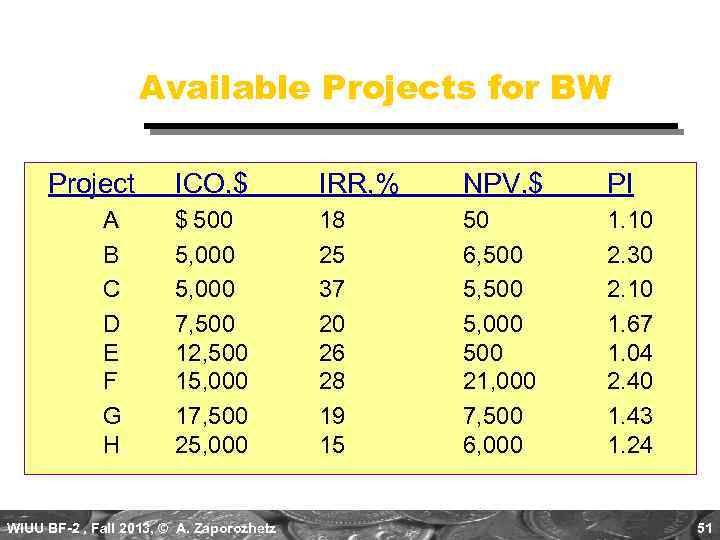
Available Projects for BW Project A B C D E F G H ICO, $ IRR, % NPV, $ PI $ 500 5, 000 7, 500 12, 500 15, 000 17, 500 25, 000 18 25 37 20 26 28 19 15 50 6, 500 5, 000 500 21, 000 7, 500 6, 000 1. 10 2. 30 2. 10 1. 67 1. 04 2. 40 1. 43 1. 24 WIUU BF-2 , Fall 2013, © A. Zaporozhetz 51
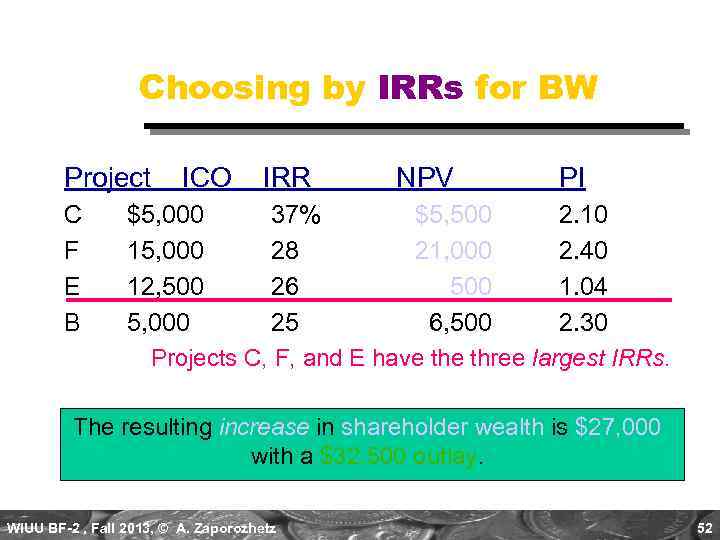
Choosing by IRRs for BW Project C F E B ICO IRR NPV PI $5, 000 37% $5, 500 2. 10 15, 000 28 21, 000 2. 40 12, 500 26 500 1. 04 5, 000 25 6, 500 2. 30 Projects C, F, and E have three largest IRRs. The resulting increase in shareholder wealth is $27, 000 with a $32, 500 outlay. WIUU BF-2 , Fall 2013, © A. Zaporozhetz 52
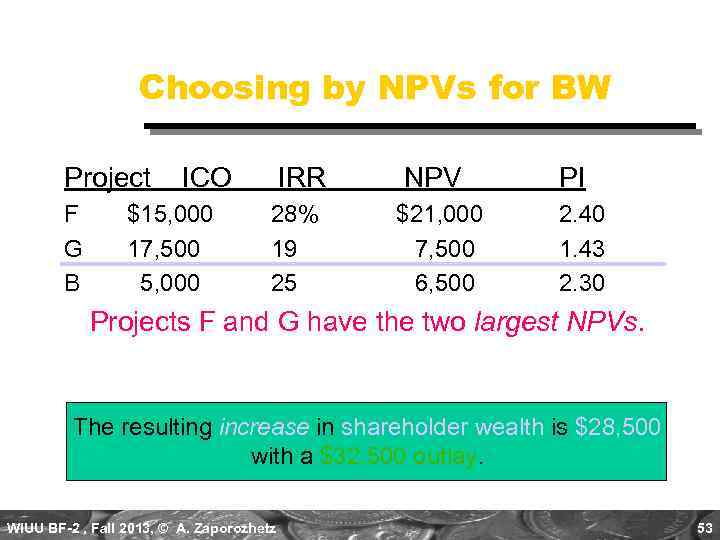
Choosing by NPVs for BW Project F G B ICO $15, 000 17, 500 5, 000 IRR 28% 19 25 NPV $21, 000 7, 500 6, 500 PI 2. 40 1. 43 2. 30 Projects F and G have the two largest NPVs. The resulting increase in shareholder wealth is $28, 500 with a $32, 500 outlay. WIUU BF-2 , Fall 2013, © A. Zaporozhetz 53
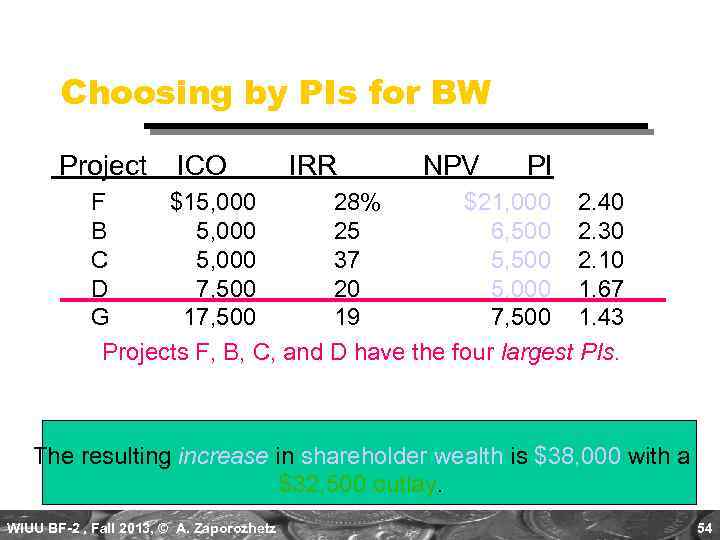
Choosing by PIs for BW Project ICO IRR NPV PI F $15, 000 28% $21, 000 2. 40 B 5, 000 25 6, 500 2. 30 C 5, 000 37 5, 500 2. 10 D 7, 500 20 5, 000 1. 67 G 17, 500 19 7, 500 1. 43 Projects F, B, C, and D have the four largest PIs. The resulting increase in shareholder wealth is $38, 000 with a $32, 500 outlay. WIUU BF-2 , Fall 2013, © A. Zaporozhetz 54
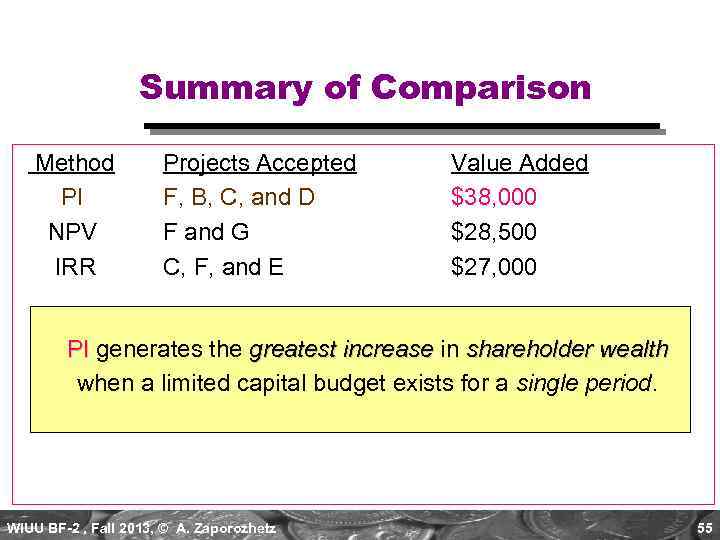
Summary of Comparison Method PI NPV IRR Projects Accepted F, B, C, and D F and G C, F, and E Value Added $38, 000 $28, 500 $27, 000 PI generates the greatest increase in shareholder wealth when a limited capital budget exists for a single period. WIUU BF-2 , Fall 2013, © A. Zaporozhetz 55
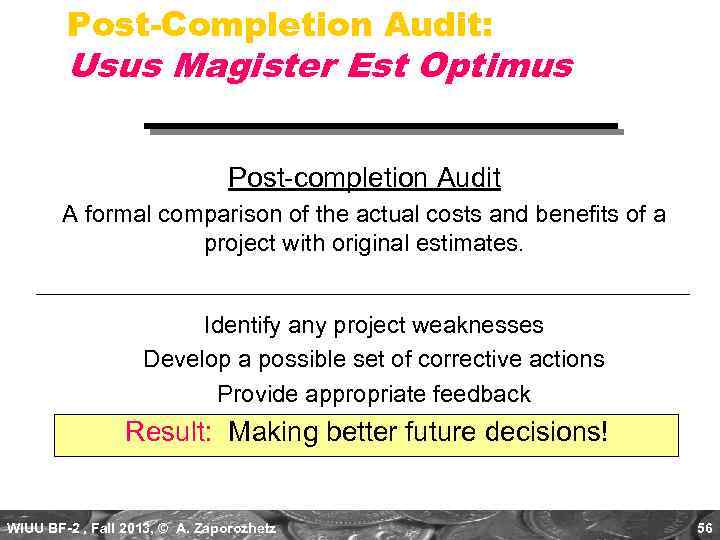
Post-Completion Audit: Usus Magister Est Optimus Post-completion Audit A formal comparison of the actual costs and benefits of a project with original estimates. Identify any project weaknesses Develop a possible set of corrective actions Provide appropriate feedback Result: Making better future decisions! WIUU BF-2 , Fall 2013, © A. Zaporozhetz 56
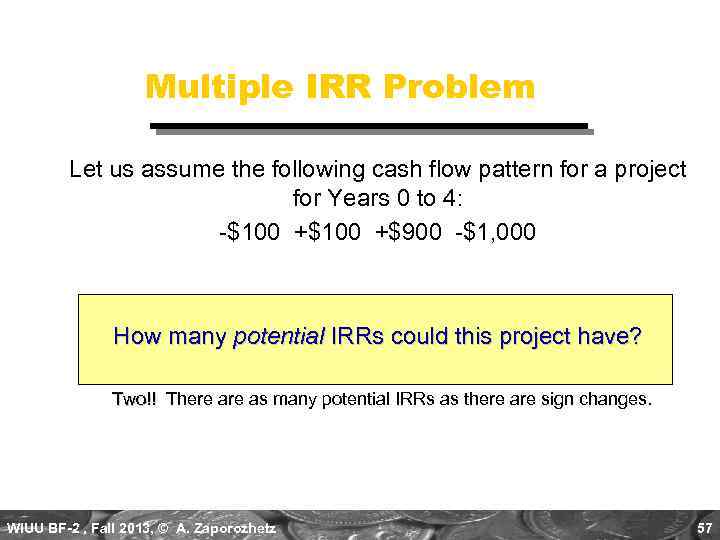
Multiple IRR Problem Let us assume the following cash flow pattern for a project for Years 0 to 4: -$100 +$900 -$1, 000 How many potential IRRs could this project have? Two!! There as many potential IRRs as there are sign changes. WIUU BF-2 , Fall 2013, © A. Zaporozhetz 57
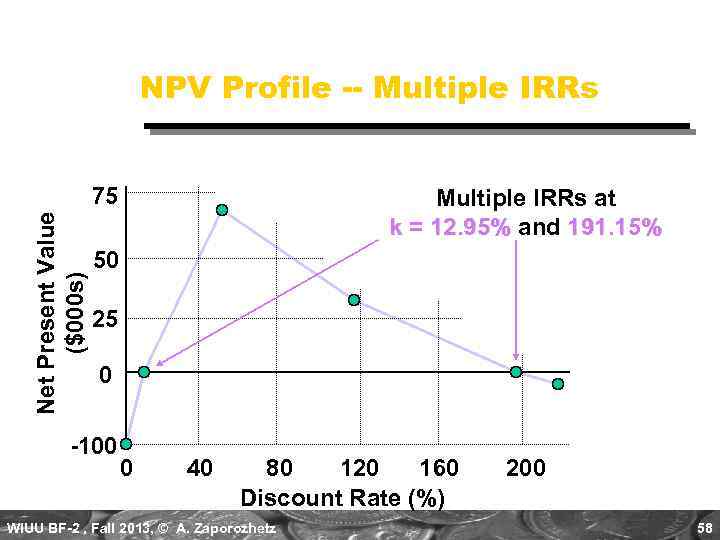
NPV Profile -- Multiple IRRs Net Present Value ($000 s) 75 Multiple IRRs at k = 12. 95% and 191. 15% 50 25 0 -100 0 40 80 120 160 Discount Rate (%) WIUU BF-2 , Fall 2013, © A. Zaporozhetz 200 58
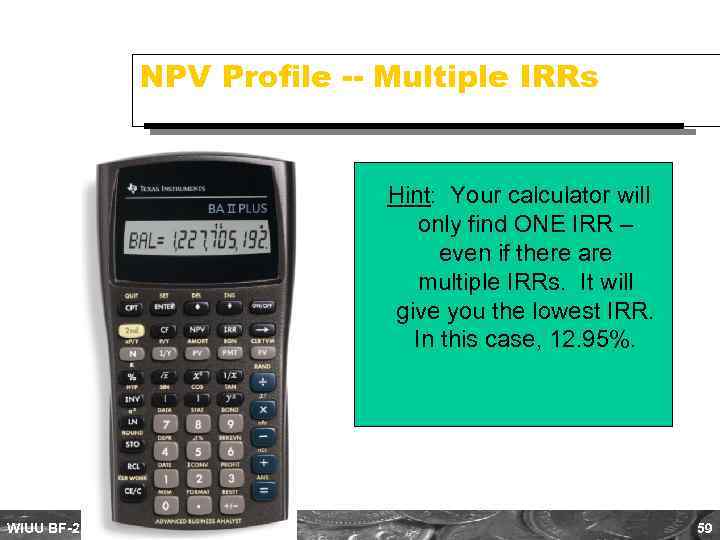
NPV Profile -- Multiple IRRs Hint: Your calculator will only find ONE IRR – even if there are multiple IRRs. It will give you the lowest IRR. In this case, 12. 95%. WIUU BF-2 , Fall 2013, © A. Zaporozhetz 59
BF2_CapBud_Fall 2013.ppt